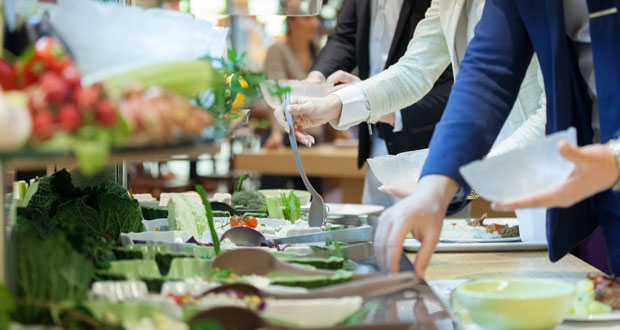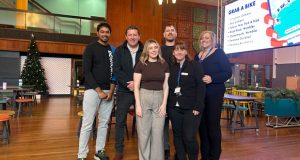 THE CONTRACT CATERING PROVIDER’S VIEW
THE CONTRACT CATERING PROVIDER’S VIEW
ANGUS BRYDON,
DIVISIONAL MANAGING DIRECTOR, BARTLETT MITCHELL.
Since we have seen the numbers increasing at workplaces over the last few months, we have had to learn and adapt to suit the needs of each location. With such variability in the numbers attending our sites, we have to ensure that the food offer is appealing, whilst managing costs and ensuring we are responsible around wastage.
As each site is different, we have adapted our models to suit the needs of the clients. Some clients have now moved to a completely free issue model where we work to a food cost and, based on the numbers on site, we create an offering that is both appealing to the customers and to the budget. This has been developed to reward those who have come back to the workplace.
Where we are still offering the traditional restaurant service, we have had to adapt the offer to control costs and minimise wastage. One huge success in this area has been the launch of the our new ‘A La Carte; service in one law firm. Using app technology, we have created the high street in the staff restaurant. Customers order from a wide menu that changes monthly, with some specials more frequent, and collect within a 12-minute window from ordering. Pre-order is also available. The menu consists of six to eight main meals (including a signature dish), pizza, salad, soups, sandwiches and specials.
As workforces are now amending the days and times they work, menu fatigue has not been an issue and often customers come back for their favourite within the month. The additional benefit is that we have been able to spec each dish, costed and nutritionally analysed to support the new laws coming in next year. Sales increased 60 per cent from the launch of the new offer. Latterly, we have adapted a hybrid style, opening a counter service due to the increase in building population.
The challenges on food prices and availability means we have had to look at things differently so we are looking even more closely at seasonal produce, allowing us to mitigate the wider societal and supply chain challenges. We have experienced that more and more of our customers are taking their time over lunch, reconnecting with their colleagues and so our food offer can be more bespoke and more made to order. Table service is also returning, reducing the need for queues and keeping social distancing in place.
One further area of success has been the use of pop ups. With the support from the clients, we have been creating an on demand offer with controlled number of portions to minimise wastage and to generate excitement and anticipation.
As we always do, we will work in partnership with our clients to tailor the offer to reach as many customers as possible, being mindful of sustainability, dietary preferences and budget requirements. There is not a one size fits all offer out there and all caterers must adapt, be flexible and above all act as the trusted advisor to the client.
 THE FM CONSULTANT’S VIEW
THE FM CONSULTANT’S VIEW
JULIAN FRIS,
DIRECTOR, NELLER DAVIES
As we have come to realise, planning can often be difficult in the current climate and ‘trends’ are difficult to predict. Hybrid solutions are unsurprising given that, on average, people are venturing into the workplace three days a week with Wednesday being the peak day followed by Tuesdays and Thursdays. This will be significantly affected if there are further lockdowns or increased restrictions, which are still a risk.
Many companies are using catering as a lure to get people back in with significant levels of discounting or even free food days (some or all). However, there is a challenge fulfilling requirements due to skills shortages in the industry. Many staff, particularly in London, are fuelling a rise in the importance of delivered-in services, such as Deliveroo, Uber Eats, and Just Eats, who have all captured a lot of ground, they don’t need expensive infrastructure, but offer significant choice from well-known brands.
Price point is also important at the moment, but customers like to exercise their right and don’t always opt for free food. After 18 months or more of uncertainty and working from home they want to re-engage with a hospitality experience. We also know that the high street has less choice these days and customers may be looking for more than another Pret or M&S sandwich. Leisure spend is rising although it is at highest risk of further COVID restrictions, but delivered-in services and meal kits have gained popularity as a result.
We have seen caterers with central production units or dark / cloud kitchens, (i.e. satellite kitchens) with highly efficient teams succeed, as we have the emergence of better-quality meals sold at value-for-money prices. The skill sets are concentrated so quality is better controlled and it is easier to control, particularly with the introduction of Natasha’s Law, which requires all food outlets to provide full ingredient lists with clear allergen labelling on Pre-Packed for Direct Sale foods (PPDS). We know from NHS caterers, who have been using this technology for over 30 years, that chill and freeze is efficient, although only as good as the quality of what you put through the system.
We are also seeing some big companies struggling to adapt because of huge losses, failing supply chains, adverse payment days, staff shortages and poor credit ratings. We also anticipate failures and mergers and acquisitions in the future, which will further constrain the market and reduce choice. This does however, present an opportunity for SMEs and social enterprises to get in on a Social Value ticket as they are more agile and not riven with debt and at the mercy of an aggressive hedge fund team.
These are all major factors in creating the new catering models for the foreseeable future and ensuring that caterers are adapting to maintain engagement in their restaurants and food. It’s important to see more collaborative working in the future, particularly with regards to measures being put in place to see how a caterer can help increase a client’s retention rate, productivity, motivation and outcomes. New models will mean caterers need to be part of the solution, not just supplying into it.
We expect that client /supplier relationships will see risk being shared as more and more joined-up approaches are taken to profits and outcomes. The sustainability piece is likely to gather pace and play a key role in how consumers wish to engage with food brands. Caterers will need to embrace sustainability, minimise wastage causation, attract small and local businesses/suppliers and look closely at cultural diversity. These are all strong differentiators for consumers.
No longer is ‘just’ good food a driver. Consumers want to know the social credentials of brands before they buy. Supply chain challenges can and are being addressed through smarter menu planning, which is important in the current climate.
Given the events of the last year, we see that smaller businesses are seizing the agenda and employers are looking at catering as an incentive to bring staff back. For all caterers we see that good food service is essential and that all customers are the purchaser not the client. Provide the quality meals at a sensible price and the customers will drive down costs naturally.





